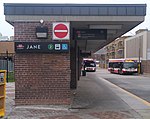Swansea, Toronto
AC with 0 elementsFormer municipalities in TorontoMetropolitan TorontoNeighbourhoods in Toronto

Swansea is a neighbourhood in the city of Toronto, Ontario, Canada, bounded on the west by the Humber River, on the north by Bloor Street, on the east by High Park and on the south by Lake Ontario. The neighbourhood was originally a separate municipality, the Village of Swansea, which was annexed by the City of Toronto in 1967.
Excerpt from the Wikipedia article Swansea, Toronto (License: CC BY-SA 3.0, Authors, Images).Swansea, Toronto
Windermere Avenue, Toronto
Geographical coordinates (GPS) Address Phone number Website Nearby Places Show on map
Geographical coordinates (GPS)
| Latitude | Longitude |
|---|---|
| N 43.643888888889 ° | E -79.477777777778 ° |
Address
Swansea Junior and Senior Public School
Windermere Avenue 207
M6S 3J9 Toronto
Ontario, Canada
Open on Google Maps








